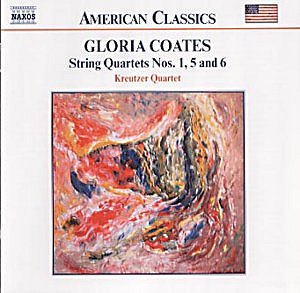As a discerning listener one sometimes has to work
hard to find one’s way into a composer’s sound-world. It may take some
considerable time; even years and sometimes we give up. I can remember
as a student determinedly concentrating on Webern and Stockhausen. Then
there are those early composers, Dufay and Machaut whose music sometimes
defies understanding. But it's normally contemporary composers who are
the most difficult as with Harrison Birtwistle. Sometimes in our frustration
we announce that the music is not worth the effort, possibly we come
to think of it as "rubbish" and dismiss it.
With Gloria Coates you are certainly going to encounter
this problem. Some of her symphonies have appeared on CD (on the CPO
label) and some other works here and there but, I’m sorry to admit that
this is the first time I have heard anything of hers. At this present
time I have to say that I have still not spent long enough with the
music to decide what to make of it. All that I can do in this review
is to try to explain what you might encounter.
The 1st Quartet; begins with an angry cello
solo incorporating the so-called Bartok pizz., tremolandi and harmonics.
The work progresses intensely and is entirely atonal. It lasts for just
a little over five minutes. It also incorporates two characteristic
fingerprints of the composer, the glissando and the canon. The latter
are sometimes difficult to pick out as they form just a small part of
the complex texture. The canon here serves as a structural device as
it did for a composer like Josquin; in other words it moves the structure
forward.
The 5th Quartet. This lasts for over thirty
minutes and has three movements entitled ‘Through time’, ‘Through Space’
and ‘In the fifth Dimension’. I was reminded, at the start, of Ligeti
especially of ‘Ramifications' (1969) with its slow moving and very stratospheric
harmonics overlapping with each other above a slow cantus firmus
like bass. But Coates holds that sound-world for the entire movement.
The second one gives less respite but its glissandi are more closely
formed as they swirl around creating massive tone clusters. Kyle Gann,
the writer of the indispensable booklet notes comments that "the
texture is carefully notated, with continuous glissandi amid fragments
of other tunes like …. "Fling out the banner". Charles Ives lies
behind the inspiration, perhaps. The third movement consists entirely
of glissandi moving in different tempi; obviously therefore constantly
employing microtones. I know of no string quartet like this anywhere.
I should add at this point that Gann does say that
Coates "should not be regarded as the glissando composer"
(despite the fact that even as a teenage student she produces a quartet
consisting entirely of glissandi which baffled her teacher) "because
there is so much more to her work". We are also reminded that she
is widely performed both in America and in Europe where she now lives.
The 6th Quartet; Lasts just about twenty-two
minutes. It begins with an aggressive snap although the opening movement
is entitled "Still". This is a slow metamorphosis starting
after the snap with close, microtonal dissonances and resolving, dare
I say, after six minutes on a chord of E minor. Kyle Gann describes
this movement as "spiritual". "Meditation" comes
next and is a set of glissandi. The web of precisely notated glissandi
has an occasional note picked out by the 1st Violin like
a distant bell. The final movement is to me a disappointment because
it is a developed recapitulation of the 1st movement. Its
title "Evanescence" is suitably descriptive. The booklet ends
by saying that Gloria Coates is "one of the most intriguing musical
voices of our time".
It appears also that she is a painter, as her 1991
abstract called ‘Tintinnabulation’ adorns the cover.
All this for less than a fiver!
Gary Higginson


